

Video below was created using images from meteor video camera SI0003, operated from Dolenja vas.
Video below was created using images from meteor video camera SI0004, operated from Dolenja vas.
Video below was created from video footage made with an Allsky7 camera, from Rezman Observatory, Slovenia. The video is reproduced at 15-times real-time speed.
Video below was created from video footage made with an Allsky7 camera, from Rezman Observatory, Slovenia. The video is reproduced at 25-times real-time speed.
Video below was created from video footage made with an Allsky7 camera, from Rezman Observatory, Slovenia. The video is reproduced at 10-times real-time speed.
Video below was created from individual photographs with Canon 6D with 24-mm f/2 lens, 10 s exposure at ISO 3200. Photographs were shot from Veliki Raven, Slovenia.
Video below was created from individual photographs with Canon 6D with 24-mm f/2 lens, 10 s exposure at ISO 3200. Photographs were shot from Medvedje Brdo, Slovenia.
Photographs bellow were shot from Kostanjevec, Slovenia (N46.39, E15.52) by Javor Kac using 28-mm f/3.3 lens and Kodak 200 film.
All potographs below were shot from Krizna Gora, Slovenia using 37-mm f/2.8 lens and Kodak 1600 film.
All potographs below were shot from Radmirje, Slovenia (14°51'E, 46°19'N) with 37-mm f/2.8 lens on Fuji 800 film.
All photographs below were shot from Slovenska Bistrica, Slovenia (15°34'E, 46°23'N) with 37-mm f/2.8 lens on Fuji 400 film.
Bright aurora were spotted as far south as 40 degrees latitude.
All potographs were shot from Slovenska Bistrica, Slovenia (15°34'E, 46°23'N) with 58-mm f/2 lens on Kodak 400. Exposure times ranged from 5 to 15 seconds.
Photographs bellow were also shot from Kostanjevec, by Javor Kac, this time using 28-mm f/3.3 lens and Kodak 200 film.
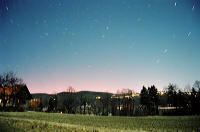
18:59:48 UT .. 462 sec
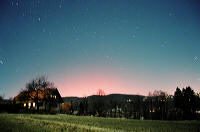
19:08:37 UT .. 285 sec
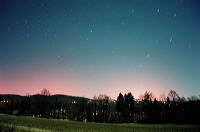
19:13:39 UT .. 348 sec
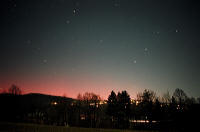
19:01:50 UT .. 151 sec
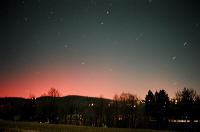
19:04:48 UT .. 332 sec
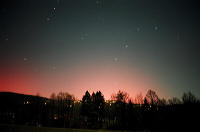
19:14:19 UT .. 215 sec
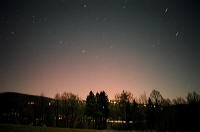
21:12:14 UT .. 430 sec
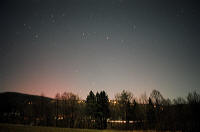
22:16:55 UT .. 150 sec
Aurora borealis from Slovenia on November 9/10, 2004!
During the nights from November 7 to 9, 2004 we witnessed a strong geomagnetic storm.
Although the aurora was most intense during daytime in Slovenia, we could still get a glimpse of a reddish glow above nothern horizon at times.

19:49 UT .. 30 sec

19:51 UT .. 40 sec

19:55 UT .. 76 sec
Aurora borealis from Slovenia on November 20/21, 2003!
On November 18, 2003 active region 10501 produced a moderate M3 flare that triggered a filament eruption and a comparatively large Earth-directed CME. The shock front reached the Earth at 8:05 UTC. The magnetic cloud contained an unusually strong southward magnetic component, which peaked at almost -60 nT while solar wind speed never exceeded 700 km/s. This created a severe geomagnetic storm, rating G4, that lasted 27 hours. Peak strength was reached in late UTC hours of November 20. Aurora was seen even from low latitudes, as far south as Turkey. Strong auroral activity was observed also from many locations in Slovenia, consisting of green, yellowish and red glows, pulsating rays, arcs, diffuse patches, and curtains reaching into the southern sky.
Aurora borealis from Slovenia on October 30/31, 2003!
In the last week of October, three giant sunspot groups (NOAA 10484, 486, 488) unleashed a number of powerful X-class flares. On October 28 an enormous X17.2 flare erupted from 486, followed by a huge X10.0 flare only 36 hours later. Both flares sent Earthwards very fast CMEs with speeds in excess of 2000 km/s. They triggered a very strong geomagnetic storm that reached G5 levels and lasted well over two days. Planetary A index reached a peak value of 192. Poor weather prevented observations during the first night of the storm, but it improved during the second night. Very active aurora was observed from 21h UT onwards in two waves of intense activity. In fact, the period of observations covers the period of the highest activity, when Kp index reached 9. The first wave coincided with a -35 nT drop in IMF, with intense red aurora reaching almost to the zenith and a greenish arc lower on the horizon. Another, slightly less intense wave came at 00:45 UT with intense red glows reaching 50 degrees high, forming pillars and rays.
Aurora borealis from Slovenia (July 15/16, 2000)!
It was a very large auroral storm. Solar wind velocities are estimated to have well exceeded 1,000 kilometers per second.
The strongest interplanetary magnetic fields to be observed in a solar disturbance since solar cycle 22 were observed on July 15/16, 2000. Values near 60 nanoteslas were observed (extremely rare), which is about 10 times the normal
background value. These intense magnetic fields contributed to the strong
geomagnetic and auroral storming.
Overall, this solar radiation storm was rated a category S4 event (on a scale between 1 and 5). There are statistically only 3 events in an entire 11 year solar cycle that reach this level of severity. It was comparable to the significant solar radiation storm of March 1989 (during solar cycle 22; we are currently in solar cycle 23).
This geomagnetic storm was classified as a G5 event (the most intense type of storm ranked). Statistically, only about 4 days in an entire 11 year solar cycle reach the G5 category, so this was a rare event.

22:19 UT

22:20 UT

22:21 UT

22:22 UT

22:23 UT
© 2000-2024 by Javor Kac